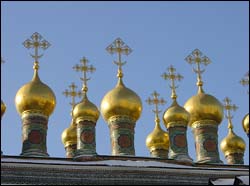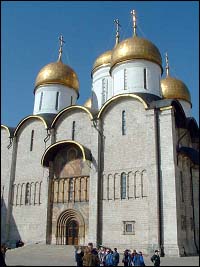 History of Moscow
History of Moscow |
Moscow was founded by Prince Yuri Vladimirovich
Dolgoruky in 1147 on the banks of the Moskva River.
Nine years later, the prince ordered the building
of wooden walls around the first settlement. At
first, the city occupied a very small part of
the future city, where the Kremlin is now located.
It was on the crossroads of the main trading routes
of all Russia. After the final battle against
the Mongol-Tatars, Dolgoruky ordered that the
first stone buildings be built.

Dmitry Donskoy, the Great Prince of the Moscow
Principality (1359-1389), ordered the building
of a stonewall around the city.
Ivan III (1462-1505), the great-grandson of Dmitry
Donskoy, completed the unification of the Russian
principalities in Moscow and ordered the construction
of more stone buildings, as well as the construction
of the Dormition, Anunciation and Archangel Michael
(Arkhangelsky) cathedrals. A new stonewall was
built around what is today called the Kremlin.
A separate wall, which still exists, was built
around the Kitai-gorod (China Town) trading area.
|

Starting in 1583, new streets were built around
the trading area and the Kremlin, as well as new
settlements. A decade later, in 1593, a white
stone wall was built around all of the settlements
by the architect of the moment, Fedor Kon, and
the area became known as the White Town.
The city developed outwards from the White Town,
surrounded by a new wall made of wood to prevent
the Tartars from attacking the city. However,
the troubles brought by the end of the Tsar dynasty
included a civil war as well as foreign aggressors.
After this period of troubles, Mikhail Romanov
was made Tsar of Russia in 1613 and this marked
the start of the Romanov Dynasty.
One hundred years later, Russia's capital was
moved to St. Petersburg by the city's founder,
Peter the Great. Moscow, however, remained important.
In the 18th century, Russia's main architects
used European architectural style in order to
create many great buildings. The city had experienced
dramatic growth, and even had a bank on its borders
charged with collecting duties on vodka.
The whole of Russia united in Moscow at the beginning
of the 19th century to fight against Napoleon
Bonaparte in 1812.
The Soviet system of government began after the
October revolution of 1917, bringing many changes
to Russia. Communist leaders ordered the reconstruction
of Moscow up to four times. This reconstruction
was based on the building of new roads, metro
stations and bridges, as well as Moscow's first
skyscrapers. At the same time, many ancient buildings
and churches were destroyed. Moscow lost many
of its architecturally historic buildings and
monuments, but today stands out in great splendour
at the centre of Russia.
|

